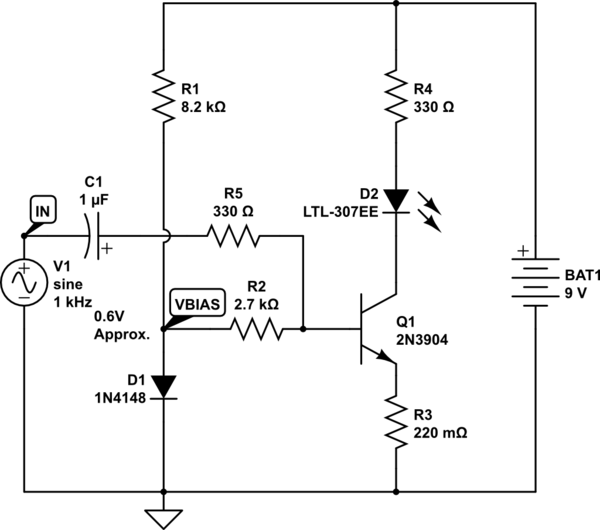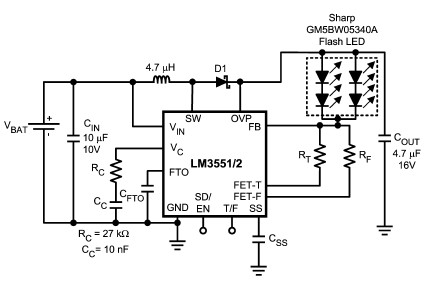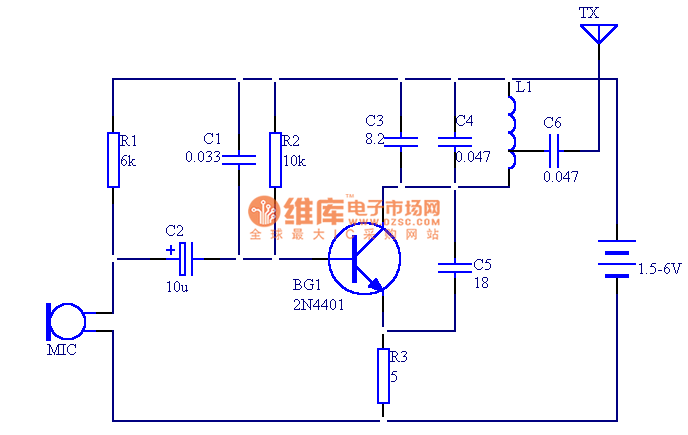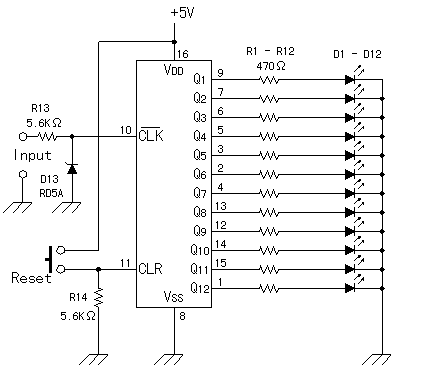
Easy 1.5 V LED flasher
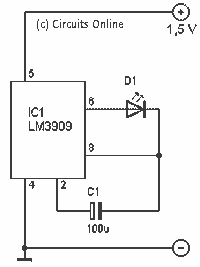
This simple flash is very compact to build in such a brooch. I have the circuit extracted from a CD cover. The flash uses a 1.5 V supply, this is a penlight or a button cell to use. Capacitor C1 controls the flash rate within certain limits. The declared value of C1 is the frequency around 1.3 Hz. More: Parts List C1 = 100 uF D1 = Low current LED IC1 = LM 3909
The provided circuit description outlines a compact LED flash circuit suitable for integration into various small applications, such as decorative brooches. The circuit is powered by a 1.5 V supply, which can be derived from a standard penlight or button cell battery. This low-voltage operation makes it ideal for portable designs where space and power efficiency are critical.
The main components of the circuit include a capacitor (C1), a low-current LED (D1), and an integrated circuit (IC1), specifically the LM 3909. The LM 3909 is a specialized LED flasher IC that is designed to drive LEDs with a flashing effect. It incorporates a timing capacitor, which in this case is C1 with a capacitance value of 100 µF. This capacitor is pivotal in determining the flash rate of the LED. The specified flash rate is approximately 1.3 Hz, indicating that the LED will turn on and off roughly once every 0.77 seconds.
In terms of functionality, when the circuit is powered on, the LM 3909 generates a square wave output that drives the LED. The timing capacitor (C1) charges and discharges, controlling the duration of the LED's on and off states. The low-current LED (D1) is selected for its efficiency and minimal power consumption, making it suitable for battery-operated devices.
The simplicity of this circuit allows for easy assembly and integration into various projects. It is essential to ensure that the connections are made correctly, particularly with respect to the polarity of the LED and the capacitor, to avoid damage to the components. Additionally, the choice of a 100 µF capacitor allows for a balance between flash duration and battery life, making it a practical choice for applications requiring intermittent lighting effects.
Overall, this compact LED flash circuit represents an efficient solution for creating visual effects in small electronic devices, combining simplicity with effective performance.This simple flash is very compact to build in such a brooch. I have the circuit extracted from a CD cover. The flash uses a 1.5 V supply, this is a penlight or a button cell to use. Capacitor C1 controls the flash rate within certain limits. The declared value of C1 is the frequency around 1.3 Hz. Parts List C1 = 100 uF D1 = Low current LED IC1 = LM 3909 🔗 External reference
The provided circuit description outlines a compact LED flash circuit suitable for integration into various small applications, such as decorative brooches. The circuit is powered by a 1.5 V supply, which can be derived from a standard penlight or button cell battery. This low-voltage operation makes it ideal for portable designs where space and power efficiency are critical.
The main components of the circuit include a capacitor (C1), a low-current LED (D1), and an integrated circuit (IC1), specifically the LM 3909. The LM 3909 is a specialized LED flasher IC that is designed to drive LEDs with a flashing effect. It incorporates a timing capacitor, which in this case is C1 with a capacitance value of 100 µF. This capacitor is pivotal in determining the flash rate of the LED. The specified flash rate is approximately 1.3 Hz, indicating that the LED will turn on and off roughly once every 0.77 seconds.
In terms of functionality, when the circuit is powered on, the LM 3909 generates a square wave output that drives the LED. The timing capacitor (C1) charges and discharges, controlling the duration of the LED's on and off states. The low-current LED (D1) is selected for its efficiency and minimal power consumption, making it suitable for battery-operated devices.
The simplicity of this circuit allows for easy assembly and integration into various projects. It is essential to ensure that the connections are made correctly, particularly with respect to the polarity of the LED and the capacitor, to avoid damage to the components. Additionally, the choice of a 100 µF capacitor allows for a balance between flash duration and battery life, making it a practical choice for applications requiring intermittent lighting effects.
Overall, this compact LED flash circuit represents an efficient solution for creating visual effects in small electronic devices, combining simplicity with effective performance.This simple flash is very compact to build in such a brooch. I have the circuit extracted from a CD cover. The flash uses a 1.5 V supply, this is a penlight or a button cell to use. Capacitor C1 controls the flash rate within certain limits. The declared value of C1 is the frequency around 1.3 Hz. Parts List C1 = 100 uF D1 = Low current LED IC1 = LM 3909 🔗 External reference
